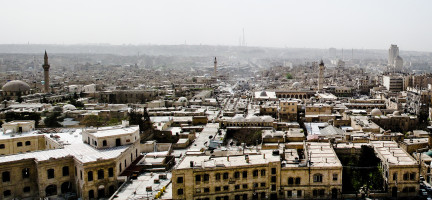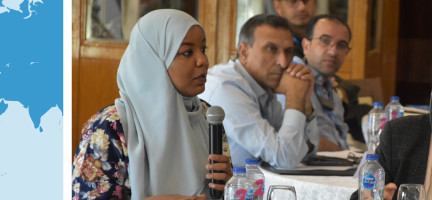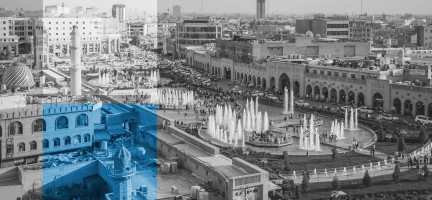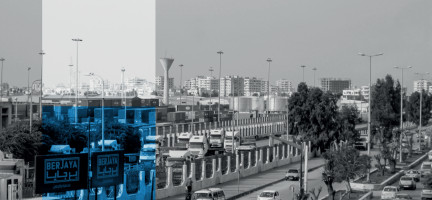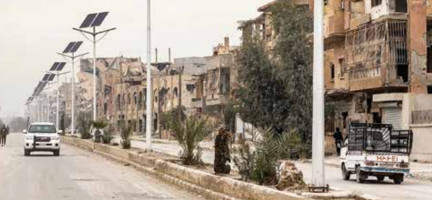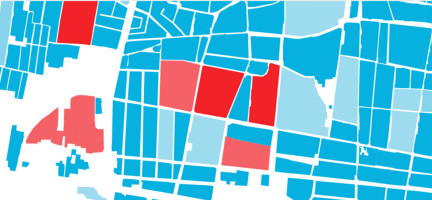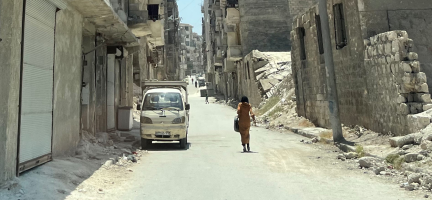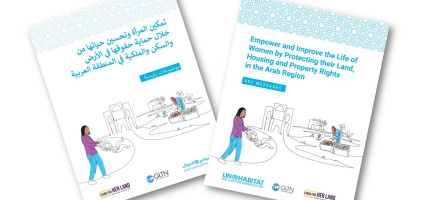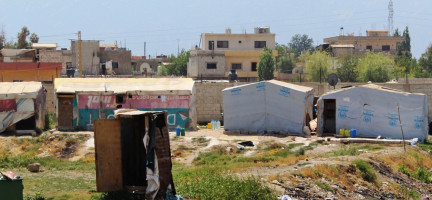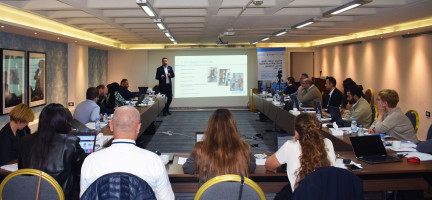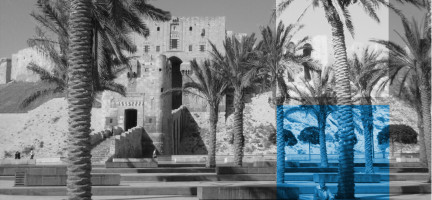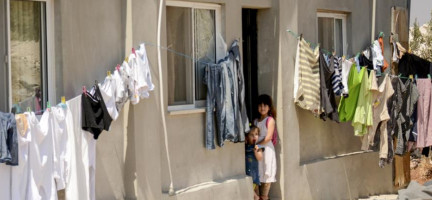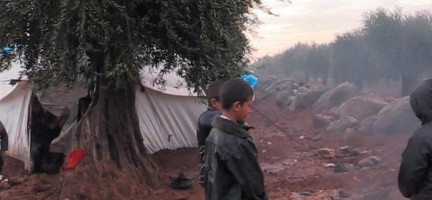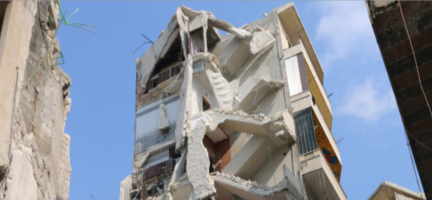Syria
The Syrian Arab Republic is located in Western Asia, with central government in the capital city, Damascus. Syria borders the Mediterranean Sea to the west, Turkey to the north, Iraq to the east and southeast, Jordan to the south, and Palestine and Lebanon to the southwest. Syria’s 185,180 Km2 surface is covered by meadows and pastures (44 per cent), arable land (33 per cent) and forests (3 per cent), while the rest is non-arable land. [1]
Syria is home to over 21 million people, 15.3 million of whom need humanitarian assistance. [2] Due to the protracted conflict, at the end of 2022, Syria counted 6.8 million internally displaced people [2]and 5.4 million Syrian refugees. [3] The earthquake that hit the northern side of the country in February 2023 aggravated the situation, affecting 8.8 million people [4], adding to the land and housing needs caused by the multiple waves of displacement experienced by the population since the start of the conflict.
Compared with other countries in the Arab region, Syria has greater agricultural potential, currently severely constrained by conflict (destruction of agricultural infrastructure, displacement, etc.) and the effects of climate change (drought, desertification and land degradation), leaving over 12 million people food insecure [5] and a cereal production at its record low since 1989. [6]
This page presents a snapshot of the Syria’s land sector. For a more exhaustive description and analysis, refer to the UN-Habitat publication “Land Administration System in Syria: Analysis and Recommendations” [7], from which this summary was extracted, and the other documents referenced in this page.
Legal and administrative framework
Syria’s very developed land-related legal framework has been evolving from the Ottoman period to present days. A rich and rapidly expanding set of laws, decrees, and resolutions - currently approximately 160 - complement each other to regulate the land sector.
Under the coordination of the Council of Ministers, numerous ministries and specialized agencies execute the various land administration functions. The effectiveness of dedicated institutions is constrained by unclear institutional mandates, lack of coordination, and inadequate human and financial resources. Since 2011, the gap between needed and available resources has become wider, severely limiting the ability of the land administration system to provide services to the Syrian people.
A comprehensive Analysis of the Syrian Urban Law was developed by UN-Habitat, providing detailed information and an analysis of specific legal instruments.
Since the start of the conflict, numerous laws and legislative decrees dealing with housing, land and property (HLP) issues have been enacted or amended, aiming at confirming the sovereignty of the state, dealing with new land and HLP challenges emerged during conflict and displacement, or facilitating the reconstruction or redevelopment of destroyed neighborhoods. Some of these laws have been condemned by the international community for failing to comply with international standards, and for weakening the housing land and property rights of displaced people and informal settlement communities.
Further, the conflict erupted in 2011 fragmented the country in areas controlled by central government and other actors. Such fragmentation has implications on the way the pre-2011 laws are being applied in the different parts of Syria and on the enactment of new laws by the various de facto governments.
Land tenure
There is a wide range of formal and informal land rights in Syria, the formal ones having evolved from the Ottoman legal tradition.
Registered land ownership
Registered land ownership rights are considered the most secure form of land rights and can be held individually or by groups. Ownership rights are registered either in the official land and property registry or in temporary registries. Official land and property records are considered to have the highest level of strength and are evidenced by a tapoo (also commonly known as “the green tapoo”).
Temporary registries are meant to secure tenure rights over formal properties (with building permits) while they are under construction, after which they should be recorded in the official registry. However, due to the complexities of the transfer process, these registries, temporary in nature, have become de facto permanent parallel registration systems.
The high level of precision and complexity of the land and property registration system provide – or used to provide before the conflict - a good level of protection which is held in high regard by both Syrian authorities and population. However, over the years, this also made the system rigid and administratively cumbersome to maintain and update. Significant differences exist between what is in the land registry and the reality on the ground.
Financial departments also host registries with accurate descriptions of properties for tax purposes. The two registries (financial and land) with different and sometimes contradictory descriptions of the same property coexist, with the taxation registry, and not the land registry, expressing a more accurate reality and enjoying the power of proof in informal areas.
Because of such complexities, official land records alone are not enough to fully protect land rights and people resort to various forms of evidence or additional evidence to strengthen their land tenure security. Commonly used ones are judicial ruling, irrevocable power of attorney and tax records. These overlapping and contradicting registries and forms of evidence burden the land administration system. The issue is analysed more in detail in the Guidance Note on Fit for Purpose Land Administration for Syria prepared by UN-Habitat, proposing a set of recommendations on how to progressively address these challenges.
Land use rights
Long-term land use rights on state land are considered very secure as well. Holders of these rights are not owners but land users with specific conditions and obligations. Long-term land rights include: usufruct rights on private ownership land (proved through a summary of registry’s record); group use rights over protected easement lands (registered in properties registry); commercial rent (proved through a document released by the finance department which includes the name of taxpayer); rent to public entities subject to obligatory renewal; land tenure through agricultural cooperative associations (proved through an official document issued by Ministry of Agriculture); usufruct rights on state’s lands (proved through a summary of registry’s record); and land tenure for housing purposes for Palestinian refugees.
Short-term land use rights are temporary rights that can be acquired and registered through rental contracts between the owner and the tenant. These include residential rents registered in the municipalities to which the property belongs (these contracts end if the building collapses or it is destroyed) and rental contracts for agricultural lands (rarely used since the tenant has the right to claim 20- 40 per cent of the land at the end of the agreement).
Informality
Land tenure rights are often not registered due to administrative or legal barriers or because the properties are in informal areas. The main types of unregistered land rights include: consent sale agreements stipulated between the seller and the buyer with the presence of witnesses and not registered with any government agency; court rulings - used for the purchase of a construction that violates land use plans or located in zones where construction is prohibited; utility bills - some informal settlements are built on the others’ lands or on public or state-owned lands provided with drinking water, electricity, telephone, and sanitation, in which case bills for these services can prove possession. The strengths of such rights and forms of evidence greatly vary according to location and political scenario. While unregistered land rights in informal settlements, for example, were considered relatively secure before the conflict, they have been significantly weakened in the last decade when informal settlements have experienced significantly more damage and displacement than formal neighborhoods.
Forms of evidence
There are many forms of evidence used to support land and property rights in Syria. The most common have been listed above but there are three very common additional forms of evidence in Syria: ownership by judicial ruling, ownership by irrevocable power of attorney, and tax records issued by finance departments. Ownership by judicial ruling which derives from when the new owner (or the buyer) files a case against the old owner (the seller) to confirm the sale agreement or to assert other real rights. Ownership by irrevocable power of attorney based on the principle that the attorney (the buyer) has a right over the principal. This method has been widely used as substitution of, or in support to, sale agreements, in registered ownerships or informal settlements.
Key challenges
No consolidated data is available, but estimates indicate that at least half of the Syrian population is tenure insecure, a number that reflects the mass displacement caused by the war, the damage and destruction of the housing stock, the fragmentation of the state under different groups, and the pre-existing dysfunctionalities and widespread corruption in the land sector.
The key challenges in providing land tenure security and registering land rights include lack of human and logistical capacity of the decentralized of land surveying services outside the main cities; the slow completion of cadastral maps even in areas where demarcation and census work has been completed; the land registration regulations that prohibit lands’ subdivision, consolidations and sales unless all shareholders are present in person; the stall of the agrarian reform; the increase of disputes between landowners and laborers in rural area; and the tendency of the farmers not to lease their land over fear of losing it (resulting to large swaths of fertile land to be out of production); and the dysfunctionalities in the housing rental market that added to the shortage of affordable housing before the crisis and will likely remain a prominent issue in the years to come. Women’s land rights and related challenges are described below.
Women’s land rights
Women’s land rights in Syria also failed to draw the attention they deserve. The laws that define access to land and property’s ownership do not differentiate between males and females, except inheritance laws for mulk lands where Islamic inheritance principles apply. However, a household survey recently undertaken by UN-Habitat in Syrian refugee communities living in Lebanon (unpublished) revealed that very few women have property titles in their name, and they are often compelled – either through social pressure or intimidation and violence - to renounce their (inferior) inheritance shares in favour of their male relatives. Other research supports the same findings. Very few women are willing to take up court cases against their family members to claim their inheritance rights as this would damage their family relationships and deprive them of the family support that serves as one of the few safety nets available to Syrian women. An additional barrier preventing many women, and particularly displaced women, from inheriting is the lack of civil documentation that can support inheritance practices, particularly marriage and death certificates of their spouses. Women’s lesser participation in the formal labour market also constrains their access to credit and their ability to purchase properties.
Land use
The concept of land use plans was not used in Syria until the creation of the Regional Planning Commission in 2010. Planning practices in Syria focus on master planning of cities and villages, while land use planning outside urban areas has been limited to defining rules and restrictions on allowed uses of lands and designating protected lands and buffer zones where development is prohibited by the ministries concerned.
There is no complete and accessible or digital land information system recording land use nor natural resources. The land use planning capacity at the national level is inadequate and outdated. Existing plans are not enforced, and regional land use plans only exist for some areas and they are rarely updated. Adequate and updated urban plans for the main and rapidly growing urban centers exist and their level of enforcement is significantly higher than for other areas, however the challenge of informal settlements has not been adequately addressed through urban law and policy issued prior to the conflict.
Agricultural land use is less regulated than urban land use and it faces adequacy and enforcement issues. There are some land use regulations related to environmental protection but their adequacy and enforcement should be improved. Protected areas and buffer zones are among the main land use directives. These areas are designated to protect important and strategic installations, natural resources - mostly regarding the use of water resources - and to restrict development activities and urban expansion.
The main challenges of the land use system include lack of respect for the characteristic of the urban communities (e.g., size, classification, capacity, social and economic characteristics, etc.); low quality of land use plans especially due the lack of feasibility studies and vision for development opportunities; lack of planning outside urban areas and lack of legal or technical distinction between urban and rural planning.
Land development
Land development in Syria takes place primarily by implementing masterplans through issuing building permits, monitoring building activities and implementing public infrastructure and facilities. The property development process in the country is considered quite difficult because of bureaucratic constraints, and the limited instruments for the public to acquire land for public use. Land readjustment interventions are years long and for this reason have limited implementation, while expropriation is usually considered unfair for the communities affected, to the point that it is considered one of the causes of informal developments in Syria, as people prefer to sell their lands into the informal markets rather than be expropriated by the government with meager compensation. Some statistics estimated that 40 per cent of the population lived in informal settlements before 2011.
Land development is still largely limited to the implementation of master plans, lands outside master plans remain subject to un-coordinated thematic permits comprising industrial, commercial, housing, services, recreational and other investment projects falling under different authorities and subject to separated permitting criteria.
Land value
A land and property taxation system exists in Syria in both urban and rural areas, and it is based on the nominal value of properties, which ranges from 50 to 75 per cent of the market value. Professional valuers exist and have been relatively recently officially recognized as a category of professionals. They are registered and somehow trained, but their services are out of reach for many and they mostly serve the banking sector and insurance companies.
The Ministry of Finance oversees the keeping of the land taxation registries at the governorate and district levels. These registries cover lands, built, and non-built properties and include a detailed description of physical characteristics, actual use, and estimated value calculated based on criteria and principles set by the law and the subsequent implementation instructions. Land taxation records are used for taxation purposes only and do not substitute the land registries, except in cases of registration of commercial use rights for the premises. Only registered properties are taxed, and the rate of tax collection is considered very low - although no consolidated data on this is available. Land and property taxes collected belong to the central government and only a little part of this amount goes back to local administrations.
Land expropriation for public purposes is regulated by Expropriation Law No. 20/1983. The value of land subject to expropriation is based on its value just before the issuance of the expropriation decree with disregard of increases caused by the expropriation proposal or speculations. Expropriation appraisal considers the value of land and the presence of buildings or other constructions, crops, trees and fruits; other rights are compensated as well.
Land dispute resolution
Syria has a dual judicial system with separate secular courts, which hear civil and criminal matters, and religious courts. The existing civil court system is considered well-structured and mostly designed to resolve conflicts and disputes over individuals’ land rights and parcel boundaries. Sharia courts perform important functions related to land management: for example they determine inheritance shares in accordance with Islamic Law and issue inheritance documents.
The current judiciary system does not have the capacity to deal with the very large number of disputes expected to arise from the waves of mass displacement caused by the war, and lack of trust among the displaced Syrian population. Alternative dispute resolution systems and transitional justice mechanisms will be required to resolve disputes related to secondary occupation, fraudulent sales, forgery of land-related documentation, forced evictions, compensation, etc.
Spatial data infrastructure
In the Syrian land administration, cadastral maps are part of the land registration system and can be used for determining land boundaries in case of disputes. Cadastral maps are generally created based on aerial imagery where physical boundaries are visible enough to demarcate boundaries. Even though most lands in Syria have undergone demarcation and census, cadastral maps of about half of these lands are still in a draft stage because their topometric computations have not been completed. The quality of the maps varies according to the expertise of the surveyors and it is further impacted by outdated technical methods and complicated bureaucratic structure.
Although access to land information in Syria should be public, cadastral maps and topographic maps are still subject to administrative restrictions and approvals. Land use information must be retrieved from various entities and there is no single authority to refer to for information on the legal and regulatory status of lands. Online resources are very limited and only a few maps and charts can be used for published scientific research and reports. Obtaining technical and legal information about land parcels is made complicated by the multiple institutions dedicated to produce information and by the lack of a shared platform.
The impact of the crisis on the land administration system
The conflict had a very heavy impact on the ability of the land administration system to deliver services to the Syrian population, leading to an almost complete cessation of activities.
Governmental programs stopped or slowed down, and private sector investments came to a standstill in most governorates. Master planning and land development activities stopped everywhere, except for a select few cities such as Damascus, Hama, Latakia, Tartous and Al-Sweida where security conditions are relatively better. Real estate investment witnessed a full stagnation, and infrastructure building and maintenance declined. With shrinking of government revenues and limited human resources caused by migration and displacement, the development projects were put on hold, and the government focused on other priorities. On the other hand, the informal housing sector continued to grow on lands not set aside for housing in the masterplan, absorbing the majority of the housing needs of the population.
Meanwhile, the war put some government reforms into effect, including the modernization of some government entities. Part of the General Directorate of Cadastral Affairs (GDCA) documents was damaged or lost (e.g., property records, contracts, cadastral maps). Buildings and equipment belonging to different land registration authorities were damaged to varying degrees. GDCA took the opportunity of the post 2011 reforms to accelerate its efforts to archive its large stocks of documents and launched a project to computerize the land registry.
There has been an almost complete suspension of urban and regional planning projects. The pre-2011 regional planning’s national framework has become obsolete, and a comprehensive review exercise is now needed. The high inflation rates, caused by the devaluation of the national currency, made land and housing unaffordable to the most.
The process for updating the land valuation methodology stalled and the revenues collected through land administration fees declined due to the reduction of property transactions and contracts registered.
The crisis years have seen an active evolution of the regulatory and legislative frameworks, particularly regarding land and property registration and transfer, the reconstruction of damaged or lost property registers, and the creation of development zones in Damascus. Some of these interventions have encountered the condemnation of international actors, on grounds of discrimination against displaced people.
Housing, Land and Property Rights of displaced people
The Syrian refugee crisis remains the largest ongoing refugee and displacement crisis in the world. [2] In 2022, Syria counted 6.8 million internally displaced people [2] and 5.6 million Syrian refugees [3] - mostly hosted the surrounding countries of Turkey, Lebanon, Jordan, Iraq and Egypt. The earthquake of February 2023 affected 8.8 million people [4] adding to the multiple waves of displacement. Violations of housing, land and property rights are widespread among the displaced population: destruction or severe damage of houses, businesses, lands and agricultural infrastructure; contamination by explosive, unauthorized secondary occupations and fraudulent sales of properties belonging to people who fled; and destruction and loss of tenure documents and civil documentation.
Property transactions are increasingly conducted informally, with a noticeable decline in the number of registered property contracts. In an attempt to curb this trend, new administrative restrictions were imposed on property transactions, lease contracts and powers of attorney related to property (e.g., preapprovals, paying electricity bills, etc.), with little results.
Despite the current challenges inside Syria, the Eight Regional Survey on Syrian Refugees’ Perceptions and Intentions on Return to Syria conducted in 2023 by UNHCR [8] among Syrian refugees living in Iraq, Lebanon, Jordan and Egypt report that the majority Syrian refugees (56.1 per cent of respondents) still hope to return one day. However, intentions to return in the short-term continue to decrease for all countries: only 1.1 per cent of Syrian refugees surveyed expressed an intention to return in the next twelve months, compared to 1.7 per cent in 2022 and 2.4 per cent in 2021. The biggest change in intentions compared to last year’s survey were recorded in Jordan and Iraq. The worsening conditions inside North-East Syria, where most of the refugees residing in Iraq originate from, are likely to be a primary factor.
29 percent of Syrian refugees expressed a hope to return in the next five years. The percentage of those hoping to return within five years was higher in Egypt (50 per cent), followed by Jordan (36 per cent), Lebanon (26 per cent), and Iraq (12 per cent). [8] Respondents across the region indicated that the main issues affecting their decision to return relate safety and security - including active conflict, a lack of law and order, military service, and the presence of armed actors-, livelihood and work opportunities, concerns over housing and property and the availability of basic services, amongst others. [9] Legal obstacles and challenges in claiming housing, land and property, and access to civil status documentation were also report as key issues. [10]
In line with the results of the surveys conducted by UNHCR, the focus group discussions conducted by UN-Habitat in December 2020 indicated that Syrian refugees in Lebanon are very concerned with their housing, land and property rights in Syria. Such concerns arise from the loss of HLP and civil documentation, multiple forms of secondary property occupation, lack of trustworthy and efficient mechanisms to recover and protect their HLP rights in their areas of origin, new urban development projects taking place in Syria, and the recent Syrian legislation hindering their HLP rights, among others. [11]
HLP issues are increasingly prominent in the humanitarian response in Syria, although effective and durable solutions at scale are yet to be developed. HLP issues have a direct impact on the affected Syrian population as well as the immediate operational work of humanitarian and recovery actors. Addressing HLP rights’ issues in conflict-affected contexts is therefore essential on many levels and across all the phases of the conflict cycle. It is crucial for the survival and the normalisation of the lives of people affected by conflict and displaced within or outside their country. It touches upon protection from violence, safety and security as a pre-condition for return, health and livelihoods. It is also essential for the realisation of a broader and interconnected set of human rights. Further, the protection of HLP rights is crucial for social reconciliation, economic recovery and to address the inequalities exacerbated during the conflict.
To address these challenges, since 2020, UN-Habitat and the Global Land Tool Network have been working in Lebanon and Iraq to improve the land tenure security and safeguard the housing, land and property rights of Syrian refugees.
References
[1] World Bank (2020). Data. Syrian Arab Republic.
[2] OCHA (2022). Syrian Arab Republic: 2023 Humanitarian Needs Overview.
[3] UNHCR (2022). Syria Situation Overview.
[4] OCHA (2023). Syrian Arab Republic: Earthquakes Syria situational updates - As of 8 March 2023.
[5] OCHA (2023). Humanitarian Response Plan 2023.
[6] FAOSTAT
[7] UN-Habitat (2022). Land Administration System in Syria: Analysis and Recommendations.
[8] UNHCR (2023). Eight Regional Survey on Syrian Refugees’ Perceptions and Intentions on Return to Syria.
[9] UNHCR (2022). Seventh Regional Survey on Syrian Refugees’ Perceptions and Intentions on Return to Syria.
[10] UNDP/UNHCR and 3RP (2019). Regional Refugee and Resilience Plan in Response to the Syria Crisis: Regional Strategic Overview 2019/2020.
[11] UN-Habitat/GLTN (unpublished). Promoting and Protecting Housing, Land and Property Rights of Syrian Refugees Living in Lebanon: Towards an Integrated Response
Disclaimer
The information contained in this page is based on the body of knowledge developed by UN-Habitat, GLTN and the Arab Land Initiative’s partners. The designations employed and the presentation of the material do not imply the expression of any opinion whatsoever on the part of the Secretariat of the United Nations concerning the legal status of any country, territory, city or area, or of its authorities, or concerning delimitation of its frontiers or boundaries, or regarding its economic system or degree of development. The information may contain inaccuracies due to the data source(s) and do not necessarily reflect the views of UN-Habitat or its governing bodies.
The Syria page is still under construction. Share with us any relevant information, resource or correction to enrich our library. Contact the Arab Land Initiative at unhabitat-arablandinitiative@un.org !
